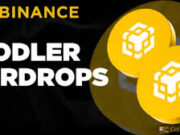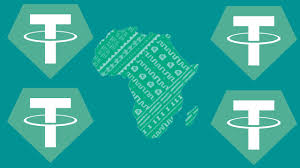Picture this: It’s a sweltering afternoon in Lagos, the kind where motorcycle horns weave into the rhythm of the city and the smell of jollof rice hangs heavy in the air. Chinedu, a small-time electronics importer, checks his phone. Overnight, the naira has slipped another 2%, shrinking his margins almost to nothing. But unlike before, he doesn’t panic. Instead, he opens his Yellow Card app, converts part of his earnings into USDT, and instantly shields his money from the storm. No banks. No endless queues. No waiting for his savings to melt away like morning dew.
Across the continent in Nairobi, Amina, a freelance graphic designer working with clients in Berlin and New York, finishes a project. Within hours, her invoice is paid in USDC, landing securely in her wallet. With a quick swap through Kotani Pay, her funds slide seamlessly into her M-Pesa account, ready for groceries or school fees. What once felt like a clunky ordeal of high fees and delayed wires now flows as smoothly as sending a WhatsApp message.
This is not a futuristic fantasy. In 2025, stablecoins like USDT (Tether) and USDC (USD Coin) have become the unsung heroes of African finance, particularly in cities like Nairobi and Lagos. Unlike the volatility of Bitcoin, stablecoins are practical. They are inflation shields, remittance lifelines, and trade enablers. According to Chainalysis, stablecoins accounted for 43% of Sub-Saharan Africa’s crypto transaction volume last year. In other words, the revolution is already here—quiet, grassroots, and deeply human.
The Economic Storm: Why Inflation and High Fees Are Forcing Change
Africa’s economies have been wrestling with severe shocks. In Nigeria, the naira lost over 70% of its value against the U.S. dollar in 2024, while inflation soared to 34% by mid-year (Cointelegraph). Kenya’s shilling, meanwhile, has been hammered by global rate hikes and climate-related food shortages, leaving households squeezed.
At the same time, remittances—the continent’s financial lifeline—remain crucial. Sub-Saharan Africa received $54 billion in 2023, with Nigeria alone pulling in $19.5 billion, nearly 35% of the regional total (Cointelegraph). However, sending money remains painfully expensive. On average, transferring just $200 through traditional services like Western Union costs 8.45% in fees, the highest in the world (Cointelegraph). That means $17 disappears before your family ever touches it.
Enter stablecoins. With digital tokens pegged 1:1 to the U.S. dollar, transactions flow across blockchains such as Tron or Ethereum with fees often under 1%. Between July 2023 and June 2024, Nigerians processed an astonishing $22 billion worth of stablecoin trades—more than any other country in the region (Mariblock). For ordinary citizens, that’s not speculation; it’s survival.
Stablecoins 101: The Simple Guide
Stablecoins are cryptocurrencies built to stay stable, unlike Bitcoin’s rollercoaster prices. USDT, launched by Tether, commands a market cap of $120 billion and runs on low-cost blockchains like Tron. USDC, managed by Circle, boasts transparency, fully audited reserves, and a $35 billion cap (Gate.io).
Access in Africa is designed to feel familiar. Yellow Card, now active in over 20 African countries, reports that more than 99% of its transactions involve stablecoins—nearly 90% in USDT and the rest largely USDC (Mariblock). Users deposit via mobile money, hold digital dollars in their wallets, and cash out through services like M-Pesa or OPay. Thanks to bridges like Kotani Pay and Transfi, exchanging USDC for local shillings or naira is as easy as topping up airtime (Transfi).
In short, stablecoins aren’t some distant Silicon Valley product—they’re local tools built into daily life.
Everyday Heroes: Stories from the Stablecoin Trenches
Take Amina in Nairobi. As a UI/UX designer, she used to lose up to 15% of her international payments to banking fees and currency conversions. “I’d wait three days for wire transfers, hoping clients paid on time,” she recalls. With USDC, she receives money instantly, converts it via Yellow Pay to M-Pesa, and keeps more of her hard-earned cash. Last month alone, she saved 500 shillings on a single gig—enough to cover her bus fare for a week.
Or consider Chinedu in Lagos’ tech hub, Yaba. Importing phone chargers from China once cost him 8% in bank fees and days of delay. “My shipments would sit in port while the money crawled,” he explains. Now, he pays suppliers directly in USDT on-chain for under $2. His profit margins? Up by 15% (Cointelegraph).
Remittances also paint a vivid picture. Fatima, a mother in Lagos, receives $400 monthly from her brother in London. Traditional systems swallowed 9% of each transfer. Today, he sends USDC straight to her phone wallet. She cashes out at a better rate than the black market, stretching her funds to buy more books for her children.
These are not isolated wins. A Chainalysis report shows that small-value transactions under $1,000 reached $3 billion in Nigeria in just the first quarter of 2024. This is real adoption, driven by necessity and powered by stablecoins.
The Remittance Revolution: Faster, Cheaper, Borderless
Remittances are more than money—they are lifelines for millions. Yet legacy systems remain stuck in outdated models riddled with intermediaries. Sending $200 from the U.S. to Nigeria costs $12–15, according to World Bank data.
Stablecoins slash that. Platforms like OnAfriq charge as little as 0.5–1% for USDT transfers, while AZA Finance and WSPN enable real-time settlements for freelancers and SMEs (Gate.io). The result? Up to 60% savings on remittance costs (Chainalysis).
Even better, mobile money integrations amplify the reach. In Kenya, M-Pesa users can now receive diaspora funds directly through stablecoin-linked services without leaving the app ecosystem (TechTrendsKE). Suddenly, borders blur. A Lagos-based exporter can pay a Nairobi supplier in USDC within seconds. For Africa’s 40% unbanked population, this is financial inclusion without bureaucracy.
Hurdles Ahead: Regulation, Risks, and the Road Forward
Of course, no financial tool is flawless. USDT has long been scrutinized for its reserve transparency, though it now provides monthly audits. USDC briefly lost its peg during the 2023 Silicon Valley Bank crisis, reminding users of inherent risks (Cointelegraph).
Scams also remain a threat, especially in peer-to-peer markets where fraudsters prey on newcomers (Yogupay). Liquidity in fiat pairs can also create slippage for large trades.
Regulators are responding. Nigeria has softened its ban on crypto banking but is moving toward stricter oversight. Meanwhile, Kenya’s central bank is experimenting with central bank digital currencies (CBDCs) as an alternative (Milken Institute). Some economists warn of “digital dollarization,” where over-reliance on stablecoins could weaken governments’ ability to manage fiscal policies (CGDEV).
Yet the momentum is undeniable. With mobile money platforms like M-Pesa processing $1 trillion annually, the marriage of stablecoins and local fintechs could supercharge Africa’s financial systems if policymakers strike the right balance.
The Bigger Picture: Africa’s Quiet Financial Uprising
Zoom out, and stablecoins represent Africa’s digital coming-of-age. They are not replacing banks or mobile money, but rather remixing them. With 70% of Yellow Card’s activity driven by personal use (remittances, savings) and 30% by businesses, the adoption split shows both breadth and resilience (Mariblock).
For individuals like Chinedu and Amina, stablecoins mean empowerment: more control, fewer losses. For families like Fatima’s, they mean dignity: remittances arriving intact. And for economies, they mean efficiency: faster trade and deeper inclusion.
As inflation bites and fees linger, stablecoins whisper a quiet promise—money that finally works for you, not against you. The question that remains is whether regulators will nurture this growth or stifle it. Either way, the future of money in Africa is already in people’s hands, flowing wallet to wallet, one transaction at a time.
Sources:
- Cointelegraph: How Africans Use Stablecoins to Beat Inflation in 2025
- Chainalysis: Sub-Saharan Africa Crypto Adoption 2024
- Yellow Card: Nigeria Leads Stablecoin Adoption
- Transfi: Stablecoin Payments in Kenya
- Gate.io: Role of Stablecoins in Africa’s Digital Economy
- Milken Institute: Global Digital Asset Adoption in Sub-Saharan Africa
- CGDEV: Risks of Digital Dollarization
- TechTrendsKE: Stablecoins and Mobile Money Integration
- Yogupay: P2P Trading Risks
- X Post by @ojhar1328 on Stablecoins in Africa



























